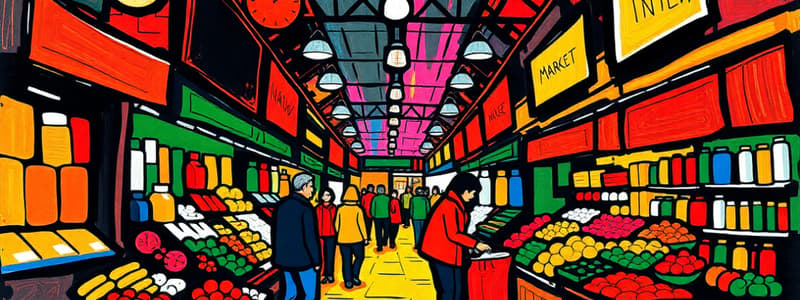Podcast
Questions and Answers
What is the minimum wage for the non-agriculture sector?
What is the minimum wage for the non-agriculture sector?
₱610.00
What is the minimum wage for retail/service establishments employing 15 workers or less?
What is the minimum wage for retail/service establishments employing 15 workers or less?
₱573.00
Tax is the _____ of the government.
Tax is the _____ of the government.
life blood
The minimum wage in the agriculture sector is higher than that of the non-agriculture sector.
The minimum wage in the agriculture sector is higher than that of the non-agriculture sector.
Signup and view all the answers
What defines a market?
What defines a market?
Signup and view all the answers
Which market is where workers offer services and look for jobs?
Which market is where workers offer services and look for jobs?
Signup and view all the answers
What is the supply function in a market?
What is the supply function in a market?
Signup and view all the answers
The Law of Demand states that as price increases, the quantity demanded for that product increases.
The Law of Demand states that as price increases, the quantity demanded for that product increases.
Signup and view all the answers
What does ceteris paribus mean?
What does ceteris paribus mean?
Signup and view all the answers
What will cause a demand curve to shift?
What will cause a demand curve to shift?
Signup and view all the answers
What is the formula for the demand function?
What is the formula for the demand function?
Signup and view all the answers
A shift in the demand curve indicates a change in the quantity demanded due to a change in price.
A shift in the demand curve indicates a change in the quantity demanded due to a change in price.
Signup and view all the answers
What does the equilibrium price represent?
What does the equilibrium price represent?
Signup and view all the answers
The formula for the supply function is Qs = ______ + 6P.
The formula for the supply function is Qs = ______ + 6P.
Signup and view all the answers
Which statement is true regarding the Law of Supply?
Which statement is true regarding the Law of Supply?
Signup and view all the answers
What is the role of the money market?
What is the role of the money market?
Signup and view all the answers
Which of the following is NOT a determinant of demand?
Which of the following is NOT a determinant of demand?
Signup and view all the answers
What is the current population of the Philippines as of September 2024?
What is the current population of the Philippines as of September 2024?
Signup and view all the answers
Which market structure is characterized by many sellers and product homogeneity?
Which market structure is characterized by many sellers and product homogeneity?
Signup and view all the answers
Study Notes
Markets
- A market is the interaction between buyers and sellers.
- Goods markets are common as they are where consumer goods are bought.
- Labor markets are where workers offer services and employers hire.
- Financial markets include stock markets, interbank markets, the money market, the bond market, and foreign exchange markets.
Demand
- Demand is a consumer's willingness to buy a good at a given price.
- The income effect occurs when a price change affects a consumer's purchasing power.
- The substitution effect occurs when a price change leads consumers to buy substitutes.
- The law of demand states that as the price of a good increases, the quantity demanded decreases, ceteris paribus.
- Non-price determinants of demand include:
- Income
- Taste
- Expectations
- Prices of related goods
- Population
Supply
- Supply refers to the quantity of goods a seller is willing to offer for sale.
- The law of supply states that as the price of a good increases, the quantity supplied increases.
- Non-price determinants of supply include:
- Cost of production
- Technology
- Availability of resources
Equilibrium
- Equilibrium is a state of balance where supply and demand are equal.
- Equilibrium price is the price at which demand and supply are equal.
- Equilibrium quantity is the quantity of goods that both buyers and sellers agree to transact at the equilibrium price.
Market Structures
- Competition is rivalry between sellers in a market.
- Perfect competition features:
- Large number of buyers and sellers
- Homogeneous products
- Perfect mobility of resources
- Perfect knowledge of market conditions
- Price determined solely by supply and demand
- Imperfect competition features products that are not identical.
- Monopoly: A single firm sells a product with no close substitutes.
- Oligopoly: A market dominated by a small number of firms.
- Monopolistic Competition: Products are differentiated, entry and exit are easy.
Philippine Economic Problems
- Labor supply refers to the population aged 15 or older willing and able to work.
- The unemployment rate in the Philippines was 3.9% in June 2024.
- The Philippines has a significant number of overseas Filipino workers (OFWs), estimated at 2.2 million in 2019.
- The Philippine peso exchange rate impacts the economy.
- Savings refer to setting aside income for future use.
- Investment is the accumulation of capital for future production and consumption.
- Rent is the payment for using land or buildings.
- Wages vary depending on the industry sector.
- Taxes are crucial for government revenue.
Studying That Suits You
Use AI to generate personalized quizzes and flashcards to suit your learning preferences.
Related Documents
Description
This quiz covers fundamental concepts in economics related to markets, demand, and supply. Examine the definitions, laws, and effects impacting buyers and sellers in various market types. Test your understanding of key economic principles and the factors influencing consumer behavior.




